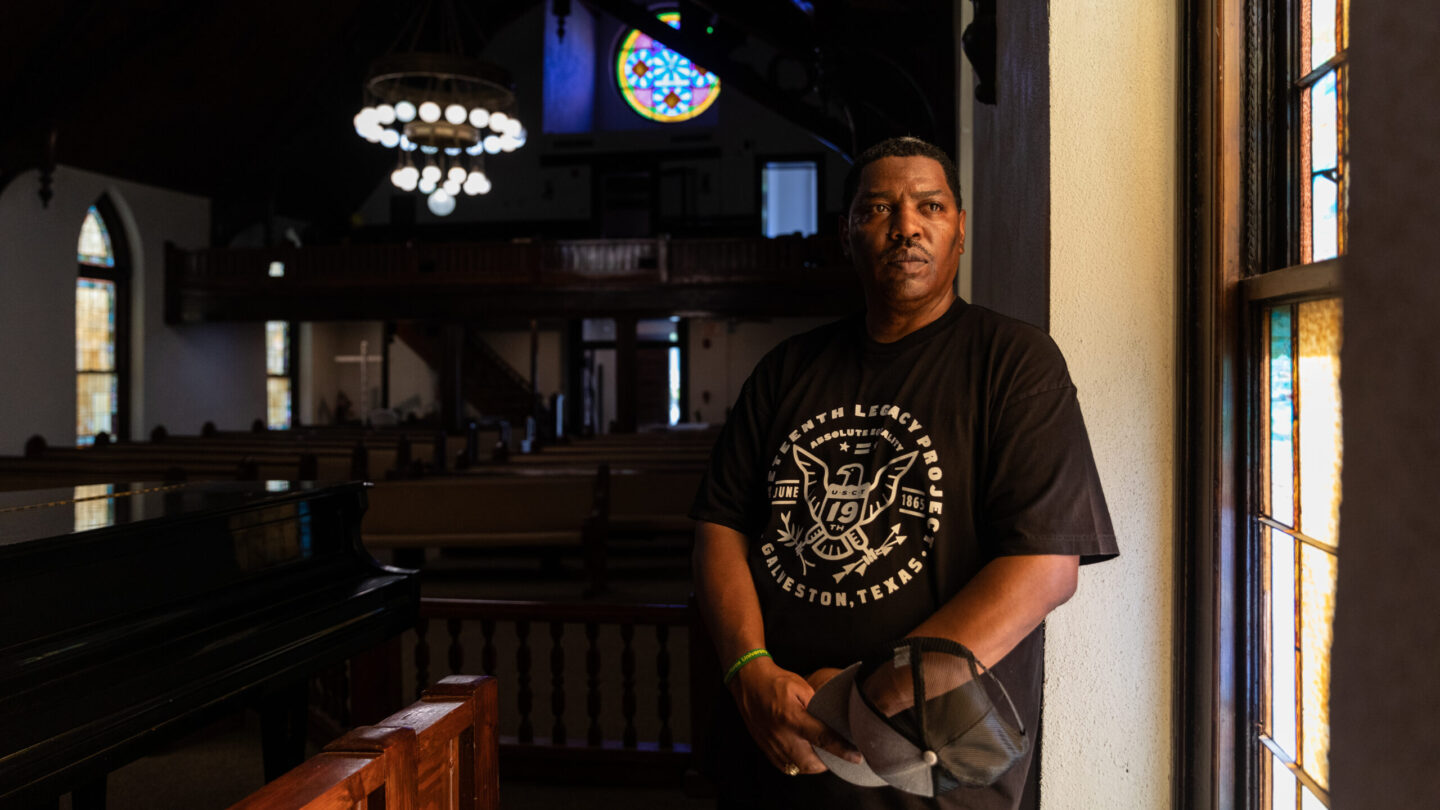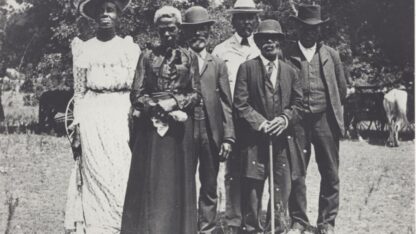GALVESTON, Texas — As a blazing sun rises over Galveston Island on the Texas coast, Sam Collins stands on the spot where history happened 157 years ago.
“The birthplace of Juneteenth is here at the southwest corner of 22nd and Strand where Gen. Gordon Granger set up his Union headquarters,” says Collins, co-chair of the Juneteenth Legacy Project and unofficial tourism ambassador of Juneteenth in Galveston. “So while Juneteenth became a national holiday last year, it has always been important to the descendants of the former enslaved here in Galveston and all throughout Texas.”
Visitors flock to this languid barrier island to splash in the warm waters of the gulf, take in the graceful, historic architecture, eat oysters and stroll along the seawall. With the new Juneteenth federal holiday, signed into law last year by President Biden, the city hopes it will also become a must-visit site of essential American history.
“You can read about Juneteenth. You can watch a documentary about Juneteenth,” Collins says, “but if you want to be immersed in the story, you have to visit Galveston, Texas, and the sites associated with June 19, 1865.”
That was the day the Union general, who had recently sailed into Galveston to take command of the District of Texas, posted a brief order to the citizenry that included the soaring words: “All slaves are free.”
The edifice occupied by Union officers is long gone. Now it’s a parking lot that looks onto a large mural depicting Juneteenth history and surrounded by ocean-themed gift shops, an Irish pub, and a store that sells toe rings.
Two and a half years before Granger arrived, President Abraham Lincoln had issued his Emancipation Proclamation that legally freed three and a half million enslaved people in Confederate states. But it was unenforceable in the defiant, slaveholding South. It wasn’t until federal troops finally arrived to occupy Galveston that Granger issued General Orders No. 3, which came to be called the Juneteenth Order, that liberated 250,000 enslaved Blacks in Texas.
Texas was the last stop for Union troops who had been marching across the Confederate South and freeing slaves as they went. What was so unique about the Juneteenth Order that it is now a federal holiday?
“That event was like lightning striking,” says Edward T. Cotham, Jr, Texas Civil War historian and author of Juneteenth, The Story Behind The Celebration. “There is not a natural freedom date for the whole country. Enslaved people were freed at massively different times. But in Texas, the Union army shows up. Now it’s over. I think that’s why enslaved people seized on that order.”
“People have been celebrating that day for 156 years,” Cotham continues. “The federal government finally made it a legal holiday.”
Sam Collins remembers his grandmother telling him oral history that was handed down through the generations among Black Galvestonians.
“It was not a piece of paper that freed enslaved people of Texas,” he says. “It was the men with the guns. These were the Union soldiers, many of them United States Colored Troops, that showed up and told the plantation owners and enslavers, ‘You have to stop. These people are free.'”
On the island, Juneteenth has always been an intensely local celebration.
“I remember celebrating Juneteenth as a little kid growing up and having barbecue and red soda water on June 19th, and the parades they had,” says Douglas Matthews, 71, former Galveston city manager and now an assistant vice president at the University of Texas Medical Branch. “At the far west end of the island where the seawall ends is the city limits. Black people could go to the beaches there but we could not celebrate anyplace else.”
A local genealogist who is BOI (born on the island) says when she was growing up Juneteenth was not even taught in school.
“It was not in any schoolbook,” says Sharon Batiste Gillins. “We celebrated Juneteenth in the family. It was a family affair. It was a church affair.”
Gillins says when she went away to Howard University in 1969, the Juneteenth celebrations were larger and more public in Washington D.C. than they had been in Galveston. It was around 1979, when Texas declared Juneteenth a state holiday, that Galveston began celebrating it in a big way.
Now that it’s a national holiday, just like MLK Day, Gillins cringes when she sees the Juneteenth party supplies in stores.
“Consistent with the American culture it’s already being commercialized,” she says. “We’re gonna see things like the Juneteenth half-off sale.”
What’s considered over the top? Last month, Wal-Mart withdrew its “Celebration Edition: Juneteenth Ice Cream,” and apologized.
For Gillins, along with local pride comes a dose of wistfulness. “We have been celebrating it for so long and now it’s national and we don’t quite own it like we used to,” she says.
Today, Juneteenth in Galveston is a week of non-stop parades, picnics, poetry readings, gospel music and Freedom Tours. Two years from now, a group of entrepreneurs hopes to have the 1861 United States Customs House restored and reopened as a Juneteenth Museum. The brick Classical Revival building was occupied by the Confederate Army during the Civil War, then reoccupied by the federal government that used it as a courthouse and post office.
Until recently, the structure was headquarters for a Texas homebuilder until earlier this year when June 19 Museum Inc., based in Washington D.C., acquired it. Company president Kevin L. Jackson says the future museum will include the history of Juneteenth along with other relevant exhibits.
“We want the Juneteenth museum to help eliminate the scourge of modern slavery and human trafficking,” Jackson says during a tour of the building. “And we envision having one of these rooms as the Escape Room which will tell the story of the Underground Railroad.”
While there is much attention paid to Galveston’s role in ending slavery in Texas, there is almost no mention of Galveston’s role in perpetuating slavery. The city, which was the state’s leading seaport and commercial center during the 19th century, had the largest slave auction house west of the Mississippi. John Seabrook Sydnor, a prominent businessman and mayor of Galveston, was the city’s major slave dealer. A newspaper ad from 1862 states, “J.S. & J.B. Sydnor Auction Sales every Tuesday. Merchandise, Real Estate, Negroes, Carriages, Furniture, Etc.” The auction house stood only a few blocks from where the Juneteenth Order was signed. There are more than 200 historical markers in Galveston, but not one that highlights the city’s role in the commerce of slavery.
“Our city puts out a very positive image, but there is a dark side to Galveston,” says Eugene Lewis, retired Galveston police commander and early Juneteenth booster. “When you look at the economic wealth, our prominent families were slaveowners.”
Beyond the history of Juneteenth, Black Galvestonians would like to see an acknowledgement of their firsts on the island: the oldest black Baptist church and the oldest African Methodist Episcopal church in Texas. The first public high school for Blacks in Texas. The home of Jack Johnson—the legendary “Galveston Giant”—who became boxing’s first African American world heavyweight champion.
For many in Galveston, Juneteenth is profoundly personal. June Collins Pulliam, director of a local music academy, traces her lineage to 1865. Her great-great-grandparents were Horace and Emily Scull, enslaved to a family named Scull on nearby Bolivar Peninsula.
“My great-great-grandparents and their young children were directly impacted,” she says, “because with this announcement of General Orders No. 3 they were then freed and able to make lives for themselves here in Galveston.”
As a freedman, Horace Scull was a skilled and sought-after carpenter. He built his own house and the houses of other emancipated people in town. His son, R.A. Scull, became a preacher and teacher, and taught in segregated Galveston schools for 52 years.
Juneteenth has come to signify so much for Black Americans throughout the country “but even moreso, I think, to those of us who are right here in Galveston where it happened,” says Pulliam. “It’s something I treasure, something I’m just glad that now the world recognizes it.”
Copyright 2022 NPR. To see more, visit https://www.npr.org.
9(MDAxODM0MDY4MDEyMTY4NDA3MzI3YjkzMw004))

9(MDAxODM0MDY4MDEyMTY4NDA3MzI3YjkzMw004))








